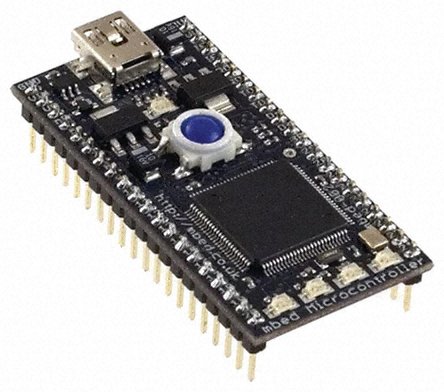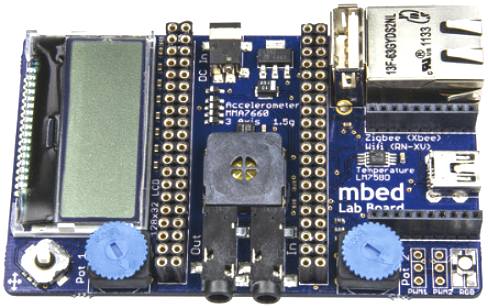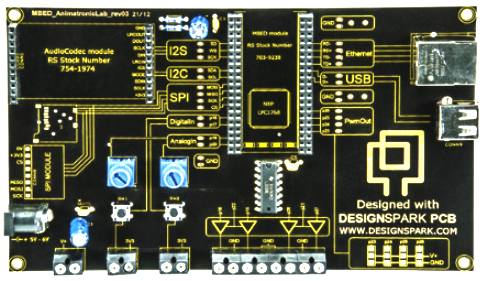|



The
Mbed NXP LPC 1768, Application and Animatronic support boards
ARM Holdings plc is a British multinational semiconductor and software design company with its head office in Cambridge, England. Its largest business is in processors, although it also designs software development tools under the RealView and Keil brands, systems and platforms, system-on-a-chip infrastructure and software. It is considered to be market dominant in the field of mobile phone chips based on the ARM architecture and is arguably the best-known of the 'Silicon Fen' companies.
The company was founded as Advanced RISC Machines, ARM, a joint venture between Acorn Computers, Apple Computer (now Apple Inc.) and VLSI Technology. The new company intended to further the development of the Acorn RISC Machine's RISC chip, which was originally used in the Acorn Archimedes and had been selected by Apple for their Newton project. The design was flexible and is now the processing core for many custom application-specific integrated circuits.
ARM Holdings has a primary listing on the London Stock Exchange and is a constituent of the FTSE 100 Index. It has a secondary listing on NASDAQ.
ARM ACRONYM
The acronym ARM, first used in 1983, originally stood for "Acorn RISC Machine." However, when the company was incorporated in 1990, the acronym was changed to stand for "Advanced RISC Machines" in the company name "Advanced RISC Machines Ltd." Then, at the time of the IPO in 1998, the company name was changed to "ARM Holdings".
COMPANY HISTORY
The Company was founded in November 1990 as Advanced RISC Machines Ltd and structured as a joint venture between Acorn Computers, Apple Computer (now Apple Inc.) and VLSI Technology. Its first profitable year was 1993. The Company's Silicon Valley and Tokyo offices were opened in 1994. In 1997, ARM Holdings invested in Palmchip Corporation to provide a system on chip platforms and to enter into the disk drive market. In 1998 the Company changed its name from Advanced RISC Machines Ltd to ARM Ltd. The Company was first listed on the London Stock Exchange and NASDAQ in 1998. Apple's shareholding had fallen to 14.8% by February 1999.
In 2010, ARM joined with IBM, Texas Instruments, Samsung, ST-Ericsson and Freescale Semiconductor in forming a Not For Profit Open Source engineering company, Linaro.
ACQUISITIONS
1999
Micrologic Solutions, a software consulting company based in Cambridge.
2000
Allant Software, a developer of debugging software; Infinite Designs, a design company based in Sheffield
EuroMIPS a smart card design house in Sophia Antipolis, France.
2001
the engineering team of Noral Micrologics, a debug hardware and software company based in Blackburn, UK.
2003
Adelante Technologies of Belgium, creating its OptimoDE data engines business, a form of lightweight DSP engine.
2004
Axys Design Automation, a developer of ESL design tools; and Artisan Components, a designer of Physical IP (standard cell libraries, Memory Compilers, PHYs etc.), the building blocks of integrated circuits.
2005
KEIL Software, a leading developer of software development tools for the microcontroller market, including 8051 and C16x platforms. ARM also acquired the engineering team of PowerEscape.
2006
Falanx (now called ARM Norway), a developer of 3D graphics accelerators, and SOISIC, who specialise in developing silicon-on-insulator physical IP.
2011
Obsidian Software Inc., a privately held company that creates processor verification
products and Prolific, a developer of automated layout optimisation software tools, and the Prolific team will join the ARM physical IP team.
2013
Internet Of Things startup Sensinode, and Cadenceís PANTA family of high-resolution display processor and scaling coprocessor IP cores.
OPERATIONS
BUSINESS MODEL
Unlike other microprocessor corporations such as AMD, Intel, Freescale (formerly Motorola) and Renesas (formerly Hitachi and Mitsubishi Electric), ARM only licenses its technology as intellectual property (IP), rather than manufacturing its own CPUs. Over forty companies do make CPUs or microcontrollers, some of them with much more expensive architectural license allowing them to make custom designs. In the fourth quarter of 2010, 1.8 billion chips based on an ARM design were manufactured.
ARM Holdings' goal is by 2015 to have ARM-based processors in more than half of all tablets, mini-notebooks and other mobile PCs sold.
FACILITIES
The company has offices and design centres across the world, including San Jose, California, Austin, Texas, and Olympia, Washington in the United States; Trondheim in Norway; Lund in Sweden; Sophia Antipolis in France; Munich in Germany; Yokohama in Japan; China, Taiwan, India, and Slovenia.
TECHNOLOGY
A characteristic feature of ARM processors is their low electric power consumption, which makes them particularly suitable for use in portable
devices. In fact, almost all modern mobile phones and personal digital assistants contain ARM CPUs, making them the most widely used 32-bit microprocessor family in the world. Today ARMs account for over 75% of all 32-bit embedded CPUs.
ARM processors are used as the main CPU for most mobile phones, including those manufactured by Apple, HTC, Nokia, Sony Ericsson and Samsung; many PDAs and handhelds, like the Apple iPod and iPad, Game Boy Advance and Nintendo DS, Game Park GP32 and GamePark Holdings GP2X; as well as many other applications, including GPS navigation devices, digital cameras, digital televisions, network devices and storage. The WLAN processor of Sony's PlayStation Portable is an ARM9.
SALES & MARKETING
ARM-based products' market share in 2010: over 95% in smartphone market; 10% in mobile computers; 35% in digital TVs and set-top boxes; however, ARM did not have any market share in servers and desktop PCs.
With Microsoft's new ARM-based Windows 8 OS coming in 2012, market research firm IHS predicted that in 2015 23% of all the PCs in the world will use ARM processors.
In May 2012, Dell announced the Copper platform, a server based on Marvellís ARM powered devices. In October 2012, ARM announced the first set of early licensees of the 64-bit-capable Cortex-A57 processor.
PARTNERSHIPS - MICROSOFT
In 2011, Microsoft demonstrated Internet Explorer 10 at the MIX11 show in Las Vegas. For around 30 seconds of the 90-minute talk, they mentioned that some of the demos were running on an ARM computer. At 2011 CES, Microsoft revealed that
the Windows 8 operating system will run on ARM architecture platforms. During Microsoft's presentation of Windows 8, a handful of the company's hardware partners showed off tablets and notebooks running the OS, including ARM Holdings instead of Intel and AMD.
UNIVERSITY
OF MICHIGAN
In 2011, ARM renewed a five-year, $5 million research partnership with University of Michigan, which extended their existing research partnership to 2015. This partnership will focus on ultra-low energy and sustainable computing.
SENIOR MANAGEMENT
Warren East was appointed Chief Executive Officer of ARM Holdings in October 2001. In the 2011 financial year, East received a total compensation of £1,187,500 from ARM, comprising a salary of £475,000 and a bonus of £712,500. East said in March 2013 that he would retire from ARM in May, with president Simon Segars taking over as CEO.
Mbed
autonomous vehicle with manual RC (drone mode) override
ARDUINO
- ARM
HOLDINGS - BEAGLEBOARD
- MBED
- PICAXE
- RASPBERRY
PI
LINKS
About
ARM
Offices
Company
Profile
Careers
Investors
Newsroom
Events
Products
Processors
System
IP
Multimedia
Physical
IP
Tools
Secure
Services
Buying
Guide
DesignStart
Markets
Embedded
Enterprise
Home
Mobile
ARM
Powered Showcase
ARM
Powered Products Search
Community
Embedded
Multimedia
SoC
Design
Software
Enablement
Smart
Connected Devices
Blogs
Forums
Social
Media
Find
an ARM Partner
Support
Services
Resources
Obtaining
Support
University
Program
ARM
Accredited Engineer Program
Site
Navigation
|


